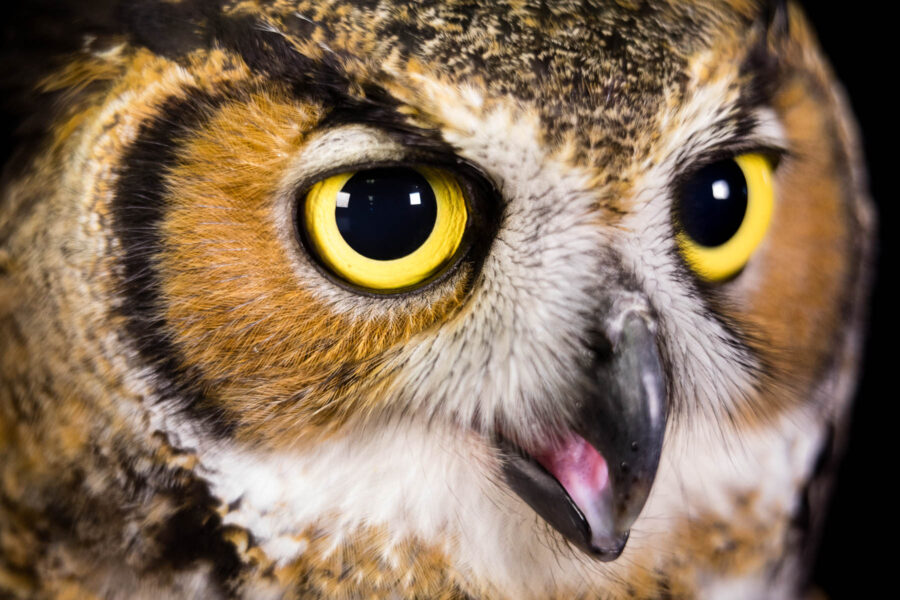Four ways owls are superior predators
Special adaptations help owls successfully hunt in all conditions

Several species of owls live in and migrate through the Chesapeake Bay watershed. These mysterious birds are an important part of the ecosystem and have adapted to being top-level predators of mammals, small birds, reptiles and even other birds of prey. From their unique eyesight to powerful talons, owls are formidable hunters that are fascinating to watch in the wild.
Top notch hearing
All owls have a set of feathers known as “facial discs” that form their round faces. These feathers work like a satellite dish to collect information, directing soundwaves toward their ears. If you’ve ever cupped your hands behind your ears to hear better, you've mimicked this system, although not nearly as effectively as an owl! Many species of owls, including barn owls and great horned owls, also have asymmetrical ears which helps them triangulate sound. Because one ear is at different level on their head than the other they know if the sound comes from left or right and up or down. In comparison, humans can detect if something is coming from left or right, but when the sound is far away, we have trouble telling if it’s above or below us. This triangulated hearing gives owls astounding accuracy when hunting, and are even able to target prey under snow from sound alone. Barn owls, which have the best hearing of their species, can catch prey in complete darkness.
Incredible sight
Owls have the ability to see great distances in daylight and at night. This is due to the size of their eyes and the relatively high number of rods and cones that allow them to adjust to different light levels while also being able to determine height and depth. Their eyes are so big that they can take up to 5% of their body weight. In saw-whet owls, you can actually see their eyes inside of their ear opening. However, owls have tube-shaped eyes (as opposed to ball-shaped like most creatures) that don’t move side to side as easily. So, in order to move their eyes to look left or right, they need to move their entire head. Luckily, owls can turn their head up to 270 degrees to look in any direction. They have 14 vertebrae in their neck, twice the number humans have, that allow them such extreme neck rotation. All of this together means they can spot a mouse in dim light up to 100 yards away.
Quiet flight
Once owls have heard and spotted their prey, they still need to ambush it to successfully catch their meal. To do so, they need to be as quiet as possible. Part of why owls can stay so quiet is because of their flight pattern. Their wings are relatively large in comparison to their bodies which allows them to lift high into the air without excessively flapping their wings and then quietly glide toward their prey. The front of their wings have comb-like feathers and the back of their wings have fringed feathers that let air pass through quietly and absorb the remaining sound. Even specialized microphones can’t pick up the sound of a barn owl in flight. A study conducted by the University of California determined that owls that hunt at night, and particularly target mammals, are more likely to have feathers adapted to silent flight than owls that hunt during the day or target fish and insects.
Strong talons
The powerful legs and talons of owls help them land, catch and kill their prey quickly. Their sturdy legs are built to stabilize them as they forcefully hit the ground to catch prey. Owls have four talons, two facing forward, one facing backwards and one that can rotate, just as a human thumb might. Extending their talons as wide as possible, and rotating their flexible one, enables them to make a large circle around their prey. If you’ve ever played a claw machine game at an arcade, think about the extra stability you could get to grab those prizes from having a fourth claw, rather than only three! Owls use their talons to catch and sever the spine of their prey. Great horned owls can exert 28 pounds of pressure with their talons. This allows them to hunt fearsome predators like osprey and falcons.
Owls live on every continent except Antarctica, and their adaptations are as diverse as the species. Scientists are still studying owls to learn more about their anatomy and how they might inspire tech innovations. Eating thousands of rodents per year, owls are also being used by farmers to keep their crops rodent free while also keeping harmful rodenticides out of the nearby environment. However, climate change and habitat loss are threatening owl populations across the country. To protect owls, we need to preserve our forests, increase native plant habitat and avoid pesticides and rodenticides. Hopefully, these amazing creatures continue to thrive and inspire generations to come.

Comments
The wise old owl how awesome
Thank you!
Your comment has been received. Before it can be published, the comment will be reviewed by our team to ensure it adheres with our rules of engagement.
Back to recent stories